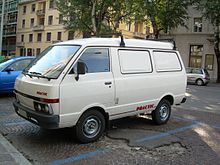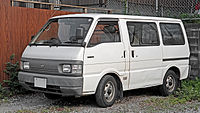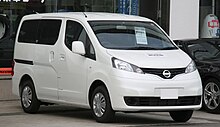Datsun Vanette
| Datsun / Nissan Vanette | |
|---|---|
| Manufacturer: | Datsun / Nissan |
| Production period: | 1978-2010 |
| Previous model: | Datsun Cherry Cab |
| Successor: | Nissan Primastar (Europe) |
The Datsun C20 (1982 Nissan Vanette) is the Japanese carmaker Datsun produced pickup truck , considered Vanversion the basis for the Vanmodelle the parent company Nissan put. When the Datsun brand was discontinued, it became the Nissan Vanette. The Vanette is based on a wide variety of small vans; the first version is based on the Datsun C20 and has mid-engines . The current Vanette in Japan is based on the Nissan NV200 pickup truck and is offered in a modified form in Europe as the Nissan Evalia . It now has a front engine .
Datsun C20 / (Datsun) Nissan Vanette C120 (1978–1988)
| C120 | |
|---|---|
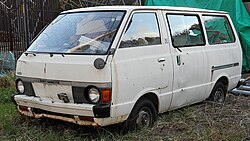
Nissan Sunny Vanette C120 |
|
| Production period: | 1978-1988 |
| Designs: | Flatbed trucks , panel vans , minibuses |
| Engines: |
Otto engines : 1.4–2.0 liters. Diesel engines : 2.0 liters |
| Length: | 2290-3900 mm |
| Width: | 1410-1600 mm |
| Height: | 1200-1800 mm |
| Wheelbase: | 2075 mm |
The "Datsun C20" (model code C120) was introduced in Japan in October 1978 as a replacement for the Datsun Cherry Cab introduced in 1969 as the Nissan Sunny Vanette / Datsun Cherry Vanette , as Nissan had three different dealer networks (Sunny / Cherry / Bluebird Line). At first there were minibuses (coach), box vans and the so-called truck version ( flatbed truck ) to buy. The drive is the 1.2-liter A12 gasoline engine, the power of which is transferred to a four-speed gearbox with steering wheel shift. Four drum brakes are installed as standard. From July 1979 the minibus version (Coach) was available with the 1.4-liter A14 gasoline engine, it has a five-speed manual transmission . The export to Europe started as the Datsun C20, but only the minibus, van and delivery truck models.
- In 1980 the 1.4-liter gasoline engine of the Coach was also offered in the other versions, and a high roof was now also available as an option.
- In June 1981 the LD20 diesel engine was introduced, coupled with a standard 5-speed manual transmission. The 2-liter Z20 gasoline engine was now available in the Coach , while the 1.2-liter gasoline engine was omitted.
- A major facelift in October 1982 brought a redesigned dashboard and standard front disc brakes on all models. The optional air conditioning system was modernized and a lower-cost FL version of the Coach was available. With the facelift, the C20 was generally renamed the Vanette . At the same time, a larger version (GC120) was introduced, which is a 33 cm version of the C120 stretched between the front and side doors. This was called Largo in Japan and mainly sold as a minibus version Datsun Vanette Largo , but was also available with all other body shapes. In Europe, the minibus version offered from 1983 (here as the KC120) replaced the smaller version.
- In September 1985, the production of the vanette C120 minibus was stopped in Japan. The KC120 version as well as the C120 truck and delivery van versions were produced in Japan until the end of 1987, the latter was only offered in Asia.
Datsun and Nissan Vanette / Van (1980–1985)
In March 1980 the Van Datsun Vanette was introduced. This is based on the C120 Coach with high roof. It has better processed materials on the dashboard and the panels, central sunroof and swiveling chairs in the 2nd row. Air conditioning for the passenger compartment was available as an option. Compared to the other versions, it has four round headlights and front disc brakes as standard. In Japan there was the Datsun Vanette or Nissan Sunny Vanette, depending on the dealer network. In Europe it was marketed as Datsun Vanette. From June 1980 the A15 petrol engine was installed and the SGL was introduced. This was externally upgraded with double angular headlights for a more modern appearance. The sliding roof in the interior is now electrically operated, and there is now also a sliding roof between the driver and front passenger seats. Air conditioning front and rear are standard, electric windows were optionally available. In June 1981 the 2.0-liter Z20 gasoline engine was installed , and export to North America began under the Nissan brand . With the facelift in 1982 and the name change from C20 to Vanette, the original Vanette became the Vanette KC120 in Europe from 1983.
Nissan Vanette Cargo C220 (1986-1994, Europe)
Exclusively for Europe, production of the Nissan Vanette Cargo C220 panel van with two standard sliding side doors and a tailgate began in 1986 at Nissan Motor Ibérica in Spain , parallel to the start of production of the Nissan Vanette C22. The Vanette Cargo is a revised panel van version of the GC120 Largo. It essentially kept the body from 1982, but with a different front. The extension of the body was no longer visible, and the dashboard of the Vanette C22 introduced in Japan in 1985 was now installed. In addition to the A15 petrol engine with 51 kW, the LD 20 diesel engine, which was recently boosted to 49 kW, was also available. This was meanwhile also available with turbo . After 8 years of construction in Europe, with a slight facelift in 1991 and a total of 12 years of construction, production of the Nissan Vanette Cargo C220 ended at the end of 1994. The successor in Europe was the Nissan Vanette Cargo HC23.
Nissan Vanette C22 (1985-1993, Japan)
| Vanette / Van C22 | |
|---|---|

Vanette C22 |
|
| Production period: | 1985-1993 |
| Designs: | Flatbed trucks , panel vans , minibuses |
| Engines: |
Otto engines : 1.4–2.4 liters Diesel engine : 2.0 liters |
| Length: | 4050 mm |
| Width: | 1635 mm |
| Height: | 1980 mm |
| Wheelbase: | 2075 mm |
The Vanette C22 appeared in September 1985. At first it was only a minibus model with the same chassis as the C20 Largo, but with a different body and a different interior. This vehicle was again marketed in Japan as the Nissan Vanette Largo . The engines are the A15 and CA20 gasoline engines and the LD20 diesel engine, optionally also with a turbocharger . In addition to the standard 5-speed manual transmission, a three-speed automatic transmission was also available for the gasoline engines. For the first time there was now also an optional all-wheel drive .
- In December 1987 the production of the Vanette Largo KC120 was stopped, the export of which to Europe had been stopped the year before.
- In November 1988, truck and panel van / station wagon versions of the C22 in Japan replaced the versions built on the basis of the C120. A 4-speed automatic transmission was now available for both the gasoline and diesel engines.
- In June 1991 the production of the Vanette truck in Japan was stopped and until 1993 it was imported from Malaysia, with a facelift with a modified front and a modified rear for the panel van / station wagon versions. The latter continued to be built in Japan until May 1993, after which all versions were replaced by the Nissan Vanette S20.
Nissan Vanette C22 (1986–1995, Europe)
The Nissan Vanette C22 was offered in Europe from October 1986 and, like the Vanette Cargo C220, was produced in Spain by Nissan Motor Ibérica . It is equipped with seven seats (2-3-2 seats) as standard. Behind the driver and front passenger seats, the vehicle has a non-foldable three-seater bench in the second row, whereby the right outer seat can be moved or folded forward. Two foldable seats are installed in the third row of seats. A folding three-seater bench for the third row of seats, which was the most frequently ordered, was also available as an option. The standard equipment includes a continuous strip of lights in the front area, power steering , central locking and additional heating in the passenger compartment. This is fully carpeted and completely covered. The SLX version also had an optional air conditioning system , a central electric sunroof , and electric windows at the front. The European Vanette is powered by the CA20 gasoline engine with a standard catalytic converter or the LD20 diesel engine with an output of 49 kW. In addition, there were optional automatic and all-wheel drive , but these were not available for the diesel engine in Europe.
- Parallel to Japan, a delivery van model based on the C22 was introduced in November 1988, which was also built in Spain.
- In 1991, Vanette's C22 van and delivery van production in Europe was discontinued in favor of the Nissan Serena C23.
The Vanette C22 was imported for Europe from Malaysia until 1995 in parallel to the successor model Serena, the van versions of the C22 were imported from Japan until the end of 1993 and replaced by the Nissan Vanette E from 1994.
Nissanvan (C22, 1985-1990, North America)
The Nissan C22 was slightly modified as the Nissanvan for North America and competed there against the Toyota van of the same size. From 1987 to 1990 the car was equipped with the more powerful 2.4-liter engine, as the 2.0-liter engine did not meet the performance expectations of the US market. Originally, the design was not designed for such a large machine, and so the new engine completely filled the engine compartment, which later led to problems with overheating and even engine fires. In 1994, Nissan took the move to buy back all of the vans it sold in the US after four recalls failed to eliminate the fire hazard from the large engine. The owners were offered compensation at least equal to the value specified in the “Blue Book” (American Schwacke list ), and most of the owners accepted the deal. But some preferred to keep their vans. In a settlement to end the class action lawsuit, plaintiffs were offered a discount on the purchase of a new Nissan. Never before or after has a complete model range been bought back from the manufacturer in the USA. The repurchased vehicles were completely scrapped.
Nissan Vanette C22 (1991-2012, Malaysia)
From 1991 to 2011, the C22 Vanettevan was produced as the Nissan Vanette Grand-Coach (high roof version) alongside the commercial Vanette C22 versions in Malaysia . When production started in 1991, the front and rear of the C22 versions were modernized. The export of the truck C22 models to Japan ended at the end of 1993. The C22 van was exported to Europe and Japan until mid-1995. Another revision including the Vanette C22 took place in 1995 and another revision in the early 2000s. Each time there was a new front and rear with revised engines, but the dashboard remained basically the same from the beginning of the C22 series in 1985. The C22 series was produced in Malaysia until the end of 2011 and, along with other Asian countries, until the beginning Sold in 2012. In these countries, the Nissan NV200 replaced the C22 series, while the production facilities were moved to Ashok Leyland in India .
Ashok Leyland Dost since 2012
The Ashok Leyland Dost has been produced in the joint Nissan and Ashok Leyland plant near Chennai in India since 2012 . This is a truck / chassis or pickup , which is also supplied with various bodies. The Dost is the first result of the 2008 joint venture between Ashok Leyland and Nissan. Originally it was also planned to produce a minibus version, but ultimately the Ashok Leyland style was added to the range. The Dost is ostensibly a new design, but the basis is provided by the Vanette C22 truck built in Malaysia until 2011. For this purpose, parts of the production facilities were also moved from Malaysia to India. As with the Vanette C22, the engine of the Dost - a 1.5-liter in-line three-cylinder common rail diesel engine - is installed as a mid-engine under the front seats. The front body and interior have been completely redesigned, but the side doors and the rest of the body are still from the Vanette C22. From 2014, the model series in Asia will also be offered outside of India.
Nissan Vanette E (1994-2002, Europe)
The Vanette E (C123) was produced in Spain from 1994 to 2002 as the successor to the van models of the Nissan Vanette C22. It is a sheet metal delivery van without side windows based on the Nissan Serena C23; this model was not available in Japan. It is powered by a 2.0-liter gasoline engine or a 2.0-liter diesel engine. It was also delivered with two sliding side doors and a tailgate as standard. Production ended in 2002 and it wasn't until the summer of 2003 that there was a successor model, the Nissan Kubistar .
Nissan Vanette Cargo III HC23 (1995-2001, Europe)
| Vanette Cargo HC23 | |
|---|---|

Vanette Cargo III |
|
| Production period: | 1995-2001 |
| Designs: | Flatbed trucks , panel vans , minibuses |
| Engines: |
Diesel engine : 2.3 liters (55 kW) |
| Length: | 4500 mm |
| Width: | 1695 mm |
| Height: | 1980 mm |
| Wheelbase: | 2895 mm |
The Vanette Cargo III (HC 23) is also based on the Nissan Serena C23, but is longer and wider than this and has a high roof that starts behind the front seats. The Vanette Cargo III, which was produced from January 1995, was also produced in Spain again and was available in Europe. In contrast to the previous model, it has two lockable rear wing doors. From 1996 there was a minibus version in addition to the completely closed box van with two sliding side doors as standard. Either as Cargo 5 or Cargo 8 (from January 1997) it had a corresponding number of seats, whereby the middle bench can be removed and the rear seats can either be removed or folded away to the side. It is powered by a 2.3-liter diesel engine with 55 kW. A driver airbag was standard in the Cargo III from the start, later a passenger airbag and anti-lock braking system were also available. The production of the Vanette Cargo III (HC23) ended in 2001. From 2002 Nissan offered the Primastar model , which replaced the Vanette Cargo in Europe.
LDV Cub
The British manufacturer LDV built a version of the Vanette Cargo HC23 under license and sold it in the UK as the LDV Cub.
Nissan Vanette S20 (1994-1999, Asia)
| Vanette S20 | |
|---|---|

|
|
| Production period: | 1994-1999 |
| Engines: |
Otto engine : 1.5-1.8 liters Diesel engine : 2.2 liters |
| Length: | 3995 mm |
| Width: | 1635-1690 mm |
| Height: | 1880-1930 mm |
| Wheelbase: | 2220 mm |
The Vanette (S20) is the first generation of Vanette that was created using badge engineering based on the Mazda Bongo . The engines used were 1.5 and 1.8 l petrol engines and a 2.2 l diesel engine. It was again available as a panel van or minibus with an optional high roof and as a flatbed truck or a pure chassis. There were also optional automatic transmissions for the gasoline engines and all-wheel drive. From 1995 an automatic transmission for the diesel engine was also available, which was revised in 1996 with an increase in output from 45 to 56 kW. The curb weight of the vehicle is given as 1330–1410 kg.
Nissan Vanette S21 (since 1999, Asia)
| Vanette S21 | |
|---|---|
| Production period: | since 1999 |
| Engines: |
Gasoline engine : 1.8 liters Diesel engine : 2.0–2.2 liters |
| Length: | 4335-4605 mm |
| Width: | 1690 mm |
| Height: | 1850-1985 mm |
| Wheelbase : | 2220 mm |
| Empty weight : | 1340-1445 kg |
| Vanette S21 | |
|---|---|
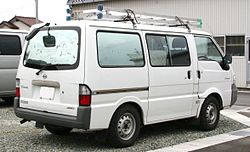
|
|
| Production period: | 1999-2010 |
| Engines: |
Gasoline engine : 1.8 liters Diesel engine : 2.0–2.2 liters |
| Length: | 4335-4605 mm |
| Width: | 1690 mm |
| Height: | 1850-1985 mm |
| Wheelbase: | 2220 mm |
The Vanette (S21) was built from June 1999 as a panel van or station wagon with a high roof and as a flatbed truck or chassis again based on the Mazda Bongo. The body and the interior have been extensively changed; they are also optionally available with airbags and ABS. Due to changed crash regulations, the front was extended. There is also a longer body version, which increases the loading area enormously. The diesel engine received direct injection and the output was increased to 58 kW, the only 1.8-liter gasoline engine now available has a turbocharger. The curb weight is given as 1340–1445 kg.
- The all-wheel drive models were available from July 1999.
- In August 2002 the driver airbag was part of the standard equipment.
- In 2003 a two-liter diesel engine replaced the older 2.2-liter engine.
- From 2007 the diesel models were equipped with a particle filter. At the same time, a new gasoline engine was introduced, which was adapted to the pollutant regulations.
- From August 2010, electrically adjustable exterior mirrors, passenger airbags, central locking with remote control and an enlarged center console were standard. A revision lowered the loading height to 45 mm. The 1.8-liter gasoline engine has also been modified and now has two overhead camshafts. The result was an increase in torque and an improvement in fuel efficiency.
- In February 2012, the production of the van and minibus models was stopped in favor of the Nissan NV200 . The pickup truck and the chassis are still produced as Nissan Vanette.
Nissan Vanette 16S / Nissan Evalia (since 2009)
The Nissan Vanette 16S has been built in Japan based on the Nissan NV200 since 2009 . In contrast to the similar Nissan Evalia model available in Europe , it is also available with automatic transmission and all-wheel drive.

